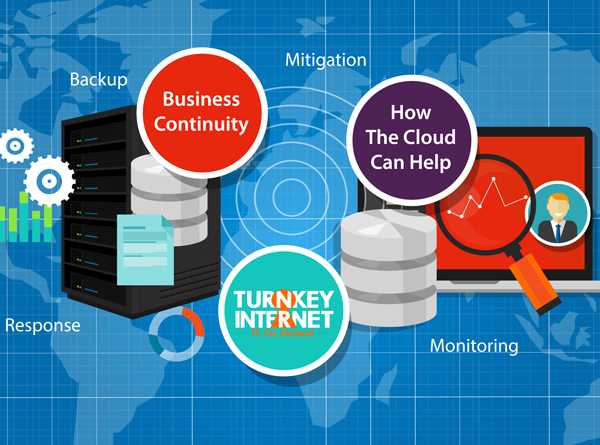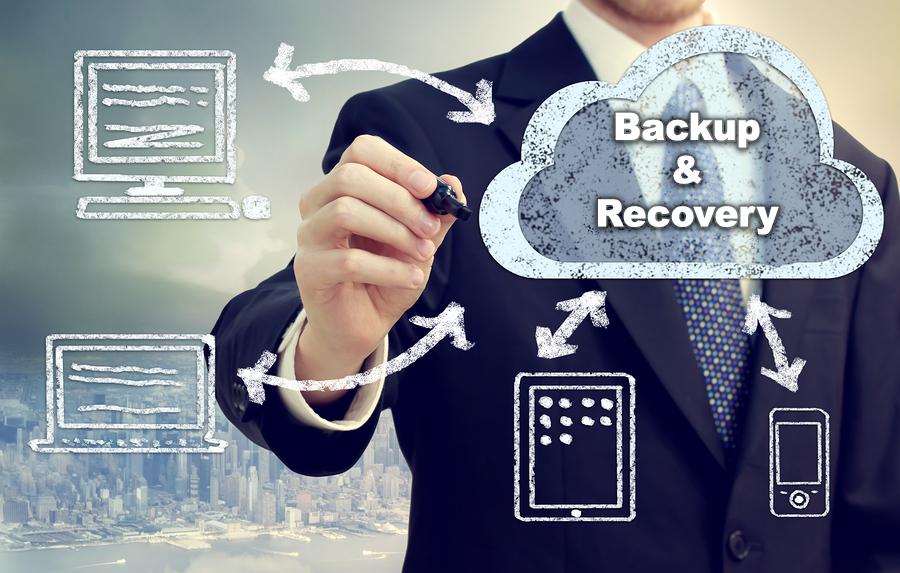Archive for the ‘cloud replication’ tag
Disaster Recovery – How to Survive When Ransomware Strikes (Infographic) no comments
DON’T GAMBLE – Be prepared when IT disasters strike
Receive a FREE consultation of your company’s Disaster Recovery Plan, visit www.TurnKeyInternet.net/myplan
Follow Us :
Share :
How Your Business Can Survive a Natural Disaster no comments

Smart business owners know the importance of planning so that they can make projections and understand the direction that their businesses need to take. In addition to traditional business plans, it is vital for companies to plan for disasters in order to protect their businesses. Natural and other disasters can cripple businesses, making it difficult for them to recover. When a disaster happens, it is important that businesses have protected their important data so that they can get back to doing business as soon as possible. Businesses that do not have in-depth Disaster Recovery Plans in place when a major natural disaster happens may not be able to recover from them. Fortunately, the advancement of technology has brought simple-to-implement and disaster-proof data protection to businesses, provided by the Cloud.
Lessons From Nature
Some business owners put off disaster recovery planning, thinking that the likelihood of something happening is minimal. Recent natural events demonstrate the importance of implementing a strong recovery plan, however. Hurricane Harvey flooded Houston with enough water that FEMA has projected it will take years for the city to fully recover. Hurricane Irma carved its own path of destruction through Florida, and Hurricane Maria caused total devastation to Puerto Rico.
While Texas, Florida and Puerto Rico are all in hurricane-prone areas, disasters can strike anywhere. The middle of the country and the South are prone to monster tornados such as the mile-wide tornado that destroyed a third of Joplin, Missouri in 2011, killing 161 people and leveling or gutting thousands of buildings, including one of the city’s two major hospitals. Similarly, the Northeastern states are also not immune from disasters as demonstrated by the ravages of Hurricane Sandy. During the winters, the Northeast and upper Midwest also face risks from crippling blizzards, which can down power lines, cause roof collapses and bring businesses to a grinding halt. The earthquake-prone West faces its own dangers of natural disasters, underscoring the importance to businesses everywhere to plan for the worst that could happen.
A common lesson from all of these disasters is that it is highly important for businesses to have backups of their data and IT infrastructure in the located off-site from their office locations and in the Cloud. Having data and IT infrastructure redundancies in the Cloud can protect a business from falling victim to power outages and other storm-related problems. Cloud technology allows businesses to store their data, servers, even their entire IT infrastructure inside a data center, with the ability to access their data as needed or to recover it quickly if disasters strike. This type of cloud solution is known as Colocation. Another cloud solution that data centers offer for businesses is Disaster Recovery as a Service or DRaaS.
DRaaS
With a DRaaS solution, businesses do not have to maintain and invest in their own remote hardware or servers. DRaaS solutions utilize Cloud Replication, in which a company’s entire IT infrastructure is replicated remotely in the cloud. This allows for a much faster recovery time because business applications can continue running over the cloud instead of waiting for data to be restored.
DRaaS offers a cloud-based solution without substantial outlays of capital. It is more service-oriented with customers paying for their consumed resources rather than paying for physical space. DRaaS is scalable, allowing businesses to expand as they need and to choose the appropriate resources for the sizes of their businesses. This means that the resources that they have available to them through DRaaS can grow with the businesses so that they remain protected at all times.
It is important for business owners to plan for everything, including the possibility that disasters may strike. When business owners have strong disaster recovery and business continuity plans in place, they may restart their businesses much faster than they might otherwise after disasters. By working in the cloud, a business’s data and applications are instantly stored so that a disaster may end up being a minor bump in the road rather than a crippling event.
Don’t gamble with your company’s data, call TurnKey Internet at 518-618-0999 and receive a free consultation of your company’s Disaster Recovery Plan. Learn more at www.TurnKeyInternet.net/myplan
Follow Us :Share :
Business Continuity: How The Cloud Can Help no comments

For many, the cloud is simply where you store your personal files with the ability to access them from anywhere. However, let’s say you wanted to backup your company’s important data and have it stored offsite, especially for your Business Continuity or Disaster Recovery plan. Until rather recently, the main option for backups were to do it all locally or on-premises. The backups were usually stored on a disk or even an additional tape drive. Larger businesses may have had another tier that sent backups off site for archiving.
Research conducted by technology research firm of Gartner Inc, shows that backups in an onsite server room or office only worked about 85% of the time. Remote offices were even worse at 75% of the time. Making matters worse, is that you do not know if you have a bad backup until you attempt to restore it. With the introduction of the cloud, the game has changed. You can now backup fast and secure to a hybrid cloud backup via cloud replication.
The hybrid cloud backup or disk-to-disk-to-cloud, allows you to maintain an initial disk backup, which is still stored in house, but has an additional tier that stores the backup in the cloud. The data can be sent in real time to a cloud based server which allows you to have a full copy of your data instantly. For example, say you have a server at your office that experiences a hardware failure, which results in 100% data loss. Since you have cloud replication enabled in your backup, you can simply download your backup from the cloud or redirect traffic to your cloud server. Since the cloud replicated your data in real time, the cloud backup, will match 100% with your dying server.
This tends to be the best of both worlds as the cloud tier is scalable, easy to manager and guarantees data restores properly. Also, restoring from the cloud is perfect for remote offices that aren’t near the local disk backup. With TurnKey Internet’s on premise cloud infrastructure, your data is available instantly and can be accessed remotely from anywhere in the world via our multiple redundant 100 gigabit fiber connections. This removes the bottleneck of your local internet service provider’s bandwidth availability, and saves potentially hours of business critical time waiting for your systems to be back in working order.
Should a disaster occur in which your infrastructure is no longer available or accessible to be restored, the need to purchase new hardware can be completely eliminated. Utilizing our existing cloud infrastructure you can be back online in minutes, not days. Employees can continue their work from home, remotely accessing images of their old workstations running live in the cloud, ensuring your business does not skip a beat.
This type of business continuity is truly invaluable, industry exclusive, and available 24/7/365. For more information and a FREE Disaster Recovery consultation, go to TurnKeyInternet.net/myplan
Follow Us :Share :
Reviewing Your Company’s Backup and Recovery Plan no comments
Is your company prepared for a catastrophe that could result in the loss of your data? You’ve most likely taken out insurance to protect yourself against natural disasters, robberies and similar catastrophic events. Your data should be no different. The only difference is that this type of insurance involves backing up your data and IT infrastructure, so that your business remains online and operational, even during one of those catastrophic situations mentioned above or something like a hardware failure or a disastrous infection. Here are some key things to focus on when reviewing your company’s existing plan or during the development of a new one:
What to Back Up
Determining what needs to be backed up should be addressed before you look at how you back it up. Do you want to back up everything that is located on computers at the office? What about data located on laptops or cellphones that are taken to and from home? Is your email or website backed up? Do you want them to be? Do you possess physical forms and documents that you want scanned into electronic form and then backed up in that form so that you are set if something such as a fire or flood destroys the hard copies?
You can back up everything, otherwise known as a full backup. This obviously requires the most storage space as well as the most time. However, it helps ensure that you will be completely back up and running in a timely manner if some disaster causes your primary data source to no longer be accessible.
However, this is not always necessary. In that case, consider an incremental or partial backup. An incremental backup involves the backing up of only files that had been created or changed since the last time your data had been backed up. This tends to be much quicker, but you do need to then ensure that you have access to several incremental backups in order to fully restore your data. It can also be difficult to organize your files or to find a specific one if you are downloading several incremental backups after disaster struck.
A partial backup means that you are only backing up part of your data, presumably the most valuable portion. However, the difference between a partial backup and a complete backup is usually minimal, meaning that, with a few exceptions, you might as well just back up everything.
Focus initially on the most important data, whatever would cause the most damage were the information to become inaccessible. These files should also be backed up more often. Of course, it does take time and money to back up your information, but it is well worth it when you consider the repercussions of losing access to it for a considerable time period or forever.
Local / Onsite Backups
Local or onsite backups involve copying and storing your data on a server or drive that is located on the same premises as your primary data source. The most significant benefit of this plan is that you can always have your secondary data right there. If something happens to your primary computer system, it’s normally easy to start utilizing the backup sources, and you don’t need to have an internet connection to do so. The cost of utilizing this type of data backup is usually relatively low, and the process of backing up your data with this method is normally pretty simple.
However, several significant disadvantages exist as well. A natural disaster such as a flood or hurricane that destroys your office or original data source will often take out your backup data too if it’s being kept onsite. And if somebody breaks in and steals your primary data, doing the same to your secondary data too can be done on the same trip.
Cloud Backup
Those taking advantage of cloud backup options will have their data sent to a remote data center on a regular basis. Probably the most significant benefit of going this route is that multiple copies of your data will can be made to stored on multiple servers located in a variety of places. That way if something disastrous happened to one place or server where your backup data was stored, you could simply access an alternate. Your data is safe at these locations as it is encrypted before being stored, and you have instantly scalable storage capacity. Another benefit is being able to automate the process so that you are not dependent on somebody remembering to back up the data.
An indirect benefit of utilizing a cloud backup method is that those who are authorized to do so can easily access the data, whether they are located across town or even on the other side of the world. This is a great benefit for organizations with multiple locations or remote staff. It’s also generally more cost effective than backing up your data onsite, due to not needing to purchase your own backup equipment. However, make sure that you research and trust the data center provider you are using to back up your data remotely.
Cloud Replication
Cloud Replication allows for the restoration of data to a virtualized server. Utilizing an off-site data center’s cloud infrastructure, data can be made available instantly, then accessed remotely from anywhere in the world over multiple, redundant, high speed networks. This removes the bottleneck of local internet service providers bandwidth availability, and saves potentially hours of business critical time by bypassing the need to wait for your onsite systems to restore and be back in working order.
Should a disaster occur in which your infrastructure is no longer available or accessible to be restored, the need to purchase new hardware can be completely eliminated. Utilizing a Cloud Replication solution can have your business back online in minutes, not days. Employees can continue their work from home, remotely accessing images of their old workstations running live in the cloud, ensuring your business does not skip a beat.
Whether it be an office fire, hardware failure, employee error, or malware infection, IT disasters are inevitable. That’s why it is critical that you have a plan in place. Don’t gamble with your company’s data, call TurnKey Internet at 518-618-0999 and receive a free consultation of your company’s Disaster Recovery Plan. Learn more at www.TurnKeyInternet.net/myplan
Follow Us :
Share :
Ransomware, Careless Employees, and IT Gremlins – Better Have Backups no comments
From buying insurance policies to installing security cameras, you take every possible step to protect your business from disaster. But you power on your computer and are met with a screen that claims to have encrypted all of your files. Unless you pay a fee before the timer expires, the program will delete your files forever. Although each situation will be different, this is what will likely happen when ransomware strikes your business.
If you store your customer data, tax information, contracts or any other important files on your network, your business can suffer. Not only will ransomware lock your files, but it can also destroy your reputation if your customers find out that your servers are not secure. When the future of your business is on the line, you can’t afford to leave yourself exposed to the threat.
Taking preventative steps to minimize the effects ransomware is a lot easier than trying to remove it. Once the ransomware takes over a computer, you won’t be able to recover your files without paying the ransom. To ensure your business is ready for a ransomware attack, you should focus on some key areas:
Employee Education
Criminals and hackers will use a range of tactics to infect a business or organization with their malicious software, including sending an email containing an infected link to one of your employees. The infected email can even be made to appear as if it came from one of your company’s email addresses. The moment your employee clicks on the link, the ransomware will jump into action and hold your files hostage. Also, if a member of your team is infected at home and brings a flash drive to work, you could have a problem on your hands.
Teaching your employees how to stay safe online is one of the top ways to protect your business from such attacks. If you want to avoid taking unneeded risks, prevent your employees from using personal devices on your network. Ensure that each person who works for you knows not to click on links unless they are sure that no danger is present. When someone from your company sends an email, have your team call the person to confirm that the email is legitimate. In addition to showing people how to stay safe when they use your network, consider putting policies in place to add an extra layer of protection.
Cloud Backups
Ransomware can easily spread across your office network, encrypting and possibly deleting all of your company’s files. If you want to do everything that you can to avoid such a disaster, consider getting an off-site dedicated server or cloud backup solution for your business. Doing so will allow you to store copies of your files outside of your infected office network, so that you can recover them after an attack.
One thing to keep in mind when searching for a cloud backup provider is storage limits. If your business has a large amount of data that will need to be backed up into the cloud, consider looking for a provider that offers an unlimited storage option.
Disaster Recovery as a Service (DRaaS)
No matter how prepared, you can never totally eliminate the threat of ransomware. Even if you have taken the step to backup all of you company’s critical files, you can still be left with the daunting task of restoring all that data as well as needing to recover your company’s entire IT infrastructure. This is where Disaster Recovery as a Service or DRaaS comes in.
With a DRaaS solution, you can have a complete backup of your business’s vital IT infrastructure at an off-site datacenter. Entire operating systems, whether it be physical or virtual, databases or individual files and folders can all safely and securely be replicated to a datacenter. Data can then be securely pushed back down to your office location, or it can even be restored into a virtual cloud environment, utilizing Cloud Replication.
Cloud Replication
DRaaS solutions that feature Cloud Replication allow for the restoration of data to a virtualized server. Utilizing an off-site datacenter’s cloud infrastructure, data can be made available instantly, then accessed remotely from anywhere in the world over multiple, redundant, high speed networks. This removes the bottleneck of local internet service providers bandwidth availability, and saves potentially hours of business critical time by bypassing the need to wait for your onsite systems to restore and be back in working order.
Should a disaster occur in which your infrastructure is no longer available or accessible to be restored, the need to purchase new hardware can be completely eliminated. Utilizing a DRaaS solution can have your business back online in minutes, not days. Employees can continue their work from home, remotely accessing images of their old workstations running live in the cloud, ensuring your business does not skip a beat.
Be Prepared When IT Disasters Strike
TurnKey Internet is Upstate New York’s only Tier IV featured Data Center providing 100% Guaranteed Uptime. We offer Colocation, IT Infrastructure, New York to California replication, on-premise 24×7 expert local staff, and the Cloud solutions to help your business succeed.
TurnKey’s DRaaS (Disaster Recovery as a Service) solution offers live Cloud Replication for your on-premise IT infrastructure to our Tier IV featured Data Center in a secure virtualized hybrid environment that is instantly available and securely accessed remotely from anywhere.
Don’t gamble, call TurnKey Internet at 518-618-0999 or visit turnkeyinternet.net/myplan to receive a FREE consultation of your company’s Disaster Recovery Plan.
Follow Us :
Share :
Cloud Backup Business Continuity : Prevention That Sizzles no comments
 When discussing Cloud Backup with our staff here at TurnKeyVault.com I am reminded of a saying from the Late Billy Mays, that said “Prevention doesn’t Sell”. The famous pitchman, and star of his own Reality Show “PitchMen” often said that your product has to have a visual “wow”, and prevention based products just don’t sizzle because you can’t effectively demonstrate and produce the WOW effect for potential buyers.
When discussing Cloud Backup with our staff here at TurnKeyVault.com I am reminded of a saying from the Late Billy Mays, that said “Prevention doesn’t Sell”. The famous pitchman, and star of his own Reality Show “PitchMen” often said that your product has to have a visual “wow”, and prevention based products just don’t sizzle because you can’t effectively demonstrate and produce the WOW effect for potential buyers.
Backing up your data, to the cloud or otherwise, is basically prevention; prevention from disaster, your own financial and corporate demise is what you ultimately are hoping to prevent. Recently some new advances in the cloud backup space have come to market, that specifically being business continuity backup services that have added some new WOW to a prevention based product line giving it some new sizzle that is getting the attention of business owners and IT managers alike. It may not have the WOW effect visually on TV of getting a stain out of a shirt, but the right backup solution will save you time, and ultimately keep you employed if you ever need it.
Cloud backups
When I say cloud backup, what immediately comes to mind? I personally imagine a white, puffy cloud in the sky that resembles a vault. Was that what came to mind for you? If not, that’s quite all right. A cloud backup is a piece of software that takes a snapshot of your server or desktop computer and then stores the data in the cloud. What exactly do I mean by the cloud? The cloud is a piece of software or data that is stored off-site that can be accessed from any location. Cloud backups allow for greater flexibility than a local disk or tape backup. A disk backup or tape backup has the limitation of only being able to access the data locally and can be damaged, lost or stolen leaving you without your backup data when you need it most. Even with cloud backup, to get back up and running from a disaster requires that you setup new computers, and copy back your data, and in many cases reconfigure and re-install most of your applications. That’s how local and cloud backups have done things for years and quite frankly it doesn’t sizzle any more like it used to.
Now there is some WOW factor – the next generation of cloud backup service offered by TurnKeyVault.com offer live cloud replication and complete business continuity. Cloud Replication allows restoration of your cloud-based backed up data to any virtualized server in rapid fashion. That means you can restore your desktop or server including the entire operating system, applications, licenses, settings, and all your data to a perfect copy just as it was before the disaster struck. Providers like TurnKey Vault even offer fully automated cloud replicated desktops and servers that utilize cloud-based infrastructure to make your data available instantly and allow you to access them remotely from anywhere in the world. The key aspect here, the sizzle, is that cloud replication removes the bottleneck of the traditional backup technologies that would rely on local internet service providers bandwidth availability, and saves potentially hours of business critical time waiting for your systems to be back in working order.
Should a disaster occur in which your infrastructure is no longer available or accessible to be restored, the need to purchase new hardware and set it up in a new office can be completely eliminated. Utilizing cloud infrastructure you can be back online in minutes, not days. Employees can continue their work from home, remotely accessing images of their old workstations running live in the cloud, ensuring your business does not skip a beat. Prevention may not sizzle on TV commercials – but in the IT world, knowing there is a business continuity plan regardless of possible disaster scenarios will leave you thinking of the WOW of your new backup plan.
Follow Us :
Share :






